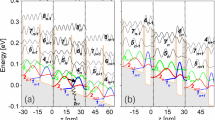Abstract
HIGH-POWER, high-coherence solid-state lasers, based on dielectric materials such as ruby or Nd:YAG (yttrium aluminium garnet), have many civilian and military applications. The active media in these lasers are insulating, and must therefore be excited (or ‘pumped’) by optical, rather than electrical, means. Conventional gas-discharge lamps can be used as the pumping source, but semiconductor diode lasers are more efficient, as their wavelength can be tailored to match the absorption properties of the lasing material. Semiconducting AlGaAs alloys are widely used for this purpose1, 2, but oxidation of the aluminium and the spreading of defects during device operation limit the lifetime of the diodes3, and hence the reliability of the system as a whole. Aluminium-free InGaAsP compounds, on the other hand, do not have these lifetime-limiting properties4–8. We report here the fabrication of high-power lasers based on InGaAsP (lattice-matched to GaAs substrates), which operate over the same wavelength range as conventional AlGaAs laser diodes and show significantly improved reliability. The other optical and electrical properties of these diodes are either comparable or superior to those of the AlGaAs system.
This is a preview of subscription content, access via your institution
Access options
Subscribe to this journal
Receive 51 print issues and online access
$199.00 per year
only $3.90 per issue
Buy this article
- Purchase on Springer Link
- Instant access to full article PDF
Prices may be subject to local taxes which are calculated during checkout
Similar content being viewed by others
References
Endriz, J. G., IEEE J. Quantum Electron. 28, 952–965 (1992).
Welsh, D. F., Chan, B., Streifer, W. & Scifres, D. R. Electron. Lett. 24, 113–115 (1988).
Fukuda, M. Reliability and Degradation of Semiconductor Lasers and LEDs (Artech House, Boston, 1991).
Garbuzov, D. Z., et al. IEEE J. Quantum Electron. 27, 1531–1535 (1991).
Razeghi, M. InGaAsP Diodes, U.S. Air Force Phillips laboratory, Diode laser technology program conference, Albuquerque, April 20–22 (1993).
Fukuda, M. J. appl. Phys. 59, 4172–4176 (1986).
Chand, N. Appl. Phys. Lett. 62, 1818–1820 (1993).
Diaz, J., et al. Electron. Lett. (Submitted).
Razeghi, M. The MOCVD Challenge (Hilger, Bristol, 1989).
Razeghi, M. in Materials for Photonic Devices (eds Andrea, A. D., Lapiccirella, A., Marietta, G. & Viticoli, S.) 15 (World Scientific, River Edge, New Jersey, 1991).
Dyment, J. C., et al. Appl. Phys. Lett. 24, 481–484 (1974).
Laser Diode Product Catalog (Spectra Diode Labs, SanJose, California, 1994).
Larsson, A., Salzman, J., Mittelstein, M. & Yariv, A. J. appl. Phys. 60, 66–68 (1986).
Sakamoto, M. & Kato, Y. Appl. Phys. Lett. 50, 869–870 (1987).
Author information
Authors and Affiliations
Rights and permissions
About this article
Cite this article
Razeghi, M. High-power laser diodes based on InGaAsP alloys. Nature 369, 631–633 (1994). https://doi.org/10.1038/369631a0
Received:
Accepted:
Issue Date:
DOI: https://doi.org/10.1038/369631a0
This article is cited by
-
Electronic and optical properties of B- and/or In-doped GaAs calculated using many-body Green’s Function theory
Chemical Research in Chinese Universities (2016)
Comments
By submitting a comment you agree to abide by our Terms and Community Guidelines. If you find something abusive or that does not comply with our terms or guidelines please flag it as inappropriate.



